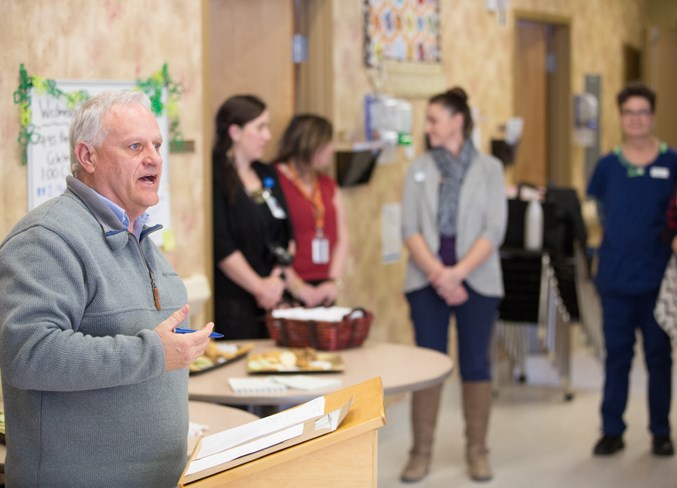The race for new, state-of-the-art Spacelabs technology at the Sundre Hospital and Care Centre launched last week.
Gerald Ingeveld, chair of the Sundre Hospital Futures Committee, offered some insight on the organization’s first major capital project fundraising campaign during the inaugural Sundre Hospital Futures Day at the facility on Wednesday, March 6 .
“We’re committing to raise $100,000 to enhance cardiac care at the Sundre Hospital and Care Centre,” said Ingeveld during a brief presentation attended by about two dozen hospital staff, patients as well as committee board members and Alberta Health Services (AHS) representatives.
“This Spacelabs monitor provides several key features that we feel Sundre needs.”
The first is to grant hospital staff the ability to remotely monitor a patient continuously from the nurses' station without physically having to be in the emergency room, he said.
“Secondly, which we think is pretty cool and very important, is that (patients) can be monitored remotely by a cardiologist anywhere in the province. So a specialist in Red Deer or Calgary or Edmonton can be getting real-time information from that monitor, allowing a cardiologist to see exactly what’s happening and subsequently make real-time decisions without having to go through several conversations to get there.”
Many hospitals have already proceeded with Spacelabs technology upgrades through assistance from foundations, and Ingeveld said the hospital futures committee decided Sundre also deserved the improvement. The goal is to have four new cardiac monitors installed at the hospital.
Over the course of several meetings with AHS in recent months, the committee worked collaboratively with the provincial health-care delivery agency to determine the hospital’s specific needs, leading to the decision to pursue efforts to obtain the Spacelabs technology, he said.
Through statistical data provided by AHS, the committee determined that instances of heart disease and related cardiac issues have been on the rise throughout Alberta, but are substantially more likely to develop in the Sundre hospital’s service area, he said.
“We’re 30 per cent more likely to be dealing with a cardiac event than the provincial average.”
There are any number of reasons to explain that trend, he said, including the higher proportion of farmers and oilfield workers among the local population.
“One of my school buddies suffered a heart attack and made the ambulance wait until he was finished feeding his cows before he would get in,” he said, drawing some laughter.
Additionally, due to the nature of Sundre’s geographic location, the community is fairly far from any modern cardiac care centres, he said.
“We don’t have direct access to cardiologists,” he said.
“But with this equipment, once here, that will change.”
Before announcing the capital campaign, Ingeveld also outlined some history about the committee, which was initially created to not only attract physicians but also to entice them to stay.
“Recruitment and retention is something that we’re broadening out to all health-care professionals in the hospital and around the community,” he said.
“The community has a lot of different health-care professionals and we need them all.”
Additionally, the committee is dedicated to advocating for the hospital and Sundre’s health-care needs by analyzing statistics and data to determine what would most benefit and enhance health-care delivery in the community, he said.
“What we’re looking at for our capital equipment purchases this year came right from those metrics.”
Since last August, he said the committee has spent about $19,500 on the following equipment: a labour- delivery sleeper chair; a labour-delivery equipment cart for the recently renovated delivery room; a bariatric lift; an electrocardiographic stretcher; as well as a Bili meter to measure light emissions from phototherapy systems.
“We’re very grateful to the community support that we’ve had in the past. That’s very important to our hospital, the community getting behind what we do,” he said.
The commitment to acquire the Spacelabs technology represents the committee’s first major capital campaign, he said, adding the intent is to reach the fundraiser’s goal one year from now.
Donations can be made at the hospital’s front desk, the committee’s website and a monthly pledge can be established with local financial institutions, he said.
“We also will be running several fundraisers as initiatives,” he said.
The campaign’s launch was also scheduled to coincide with the committee’s annual hospital staff appreciation day.
“When we began as a recruitment and retention committee, we found out that health-care professionals — we always knew that there was a lot of stress and challenges, especially in a rural hospital — don’t always know that we appreciate them,” he said.
“We can tell them that, but we have to say it more often. We have to say it as a community that we appreciate our staff.”



